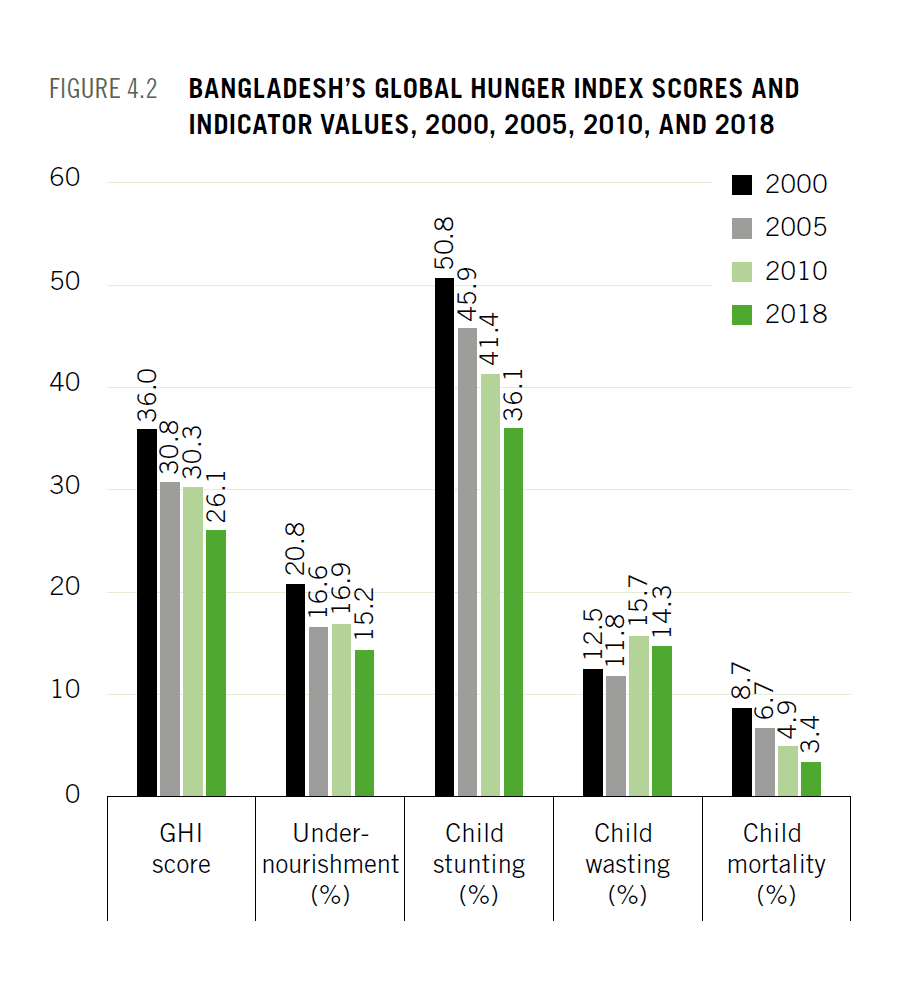The following are some of the key policies and frameworks designed to promote food and nutrition security in Bangladesh. The list is by no means exhaustive, but it highlights the government’s expressed commitment and dedication to ensuring food and nutrition security for the country.
-
Bangladesh’s national development framework is Vision 2021, which seeks to turn the country into a middle-income economy from which poverty has been virtually eradicated by 2021. The Seventh Five-Year Plan (7FYP, 2016–2020) details the means to achieve Vision 2021 and includes the objective of achieving an adequate and stable supply of safe and nutritious food for all, especially women and children. It includes interventions in a variety of relevant sectors, including agriculture, fisheries, and livestock; water and sanitation; food; education; and women and children’s affairs (Compact2025 2016).
-
The objective of the National Agriculture Policy is to “make the nation self-sufficient in food through increasing production of all crops, including cereals, and ensure a dependable food security system for all.” Additional objectives include empowering women and encouraging production of diversified, nutritious crops (Compact2025 2016).
-
Launched in 2006, the National Food Policy (NFP) has the goal of ensuring “a dependable food security system for all people of the country at all times” by meeting three objectives: (1) ensuring an adequate and stable supply of safe and nutritious food; (2) enhancing people’s purchasing power for increased food accessibility; and (3) ensuring adequate nutrition for all (especially women and children). The NFP has been implemented and monitored by the National Plan of Action (POA, 2008-2015) and funded through the Country Investment Plan (CIP) (Compact2025 2016). The NFP and POA are currently under revision by the Ministry of Food (Osmani et al. 2016), and the Second Country Investment Plan (CIP2) on Nutrition Sensitive Food Systems has been finalized.
-
The National Nutrition Policy (NNP, 2015) seeks to improve the nutritional status of Bangladeshis by ensuring the availability of adequate and safe food as well as the diversification of diets. The NNP takes a multisectoral approach and includes both nutrition-specific interventions, such as breastfeeding promotion programs, and nutrition-sensitive interventions, such as agricultural programs to promote micronutrient-rich foods (FAO 2016; Osmani et al. 2016). The Second National Plan of Action for Nutrition (NPAN2, 2016–2025), a multisectoral plan aligned with the NNP, focuses on children, adolescent girls, pregnant women, and lactating mothers. The NNP and NPAN2 are developed and led by the Ministry of Health and Family Welfare (MoHFW) (ReliefWeb 2017).
-
Instituted in 2008, the National Policy for Women’s Advancement is intended to “eliminate discrimination against women, eradicate the persistent burden of poverty on women and enhance women’s economic integration.” The National Women Development Policy (2011) “promotes women’s equality and greater rights for women in terms of employment, property and inheritance” (FAO 2016). These policies have the potential to improve food and nutrition security because of the positive association of women’s empowerment and control of income and other resources with food and nutrition security (van den Bold, Quisumbing, and Gillespie 2013).

